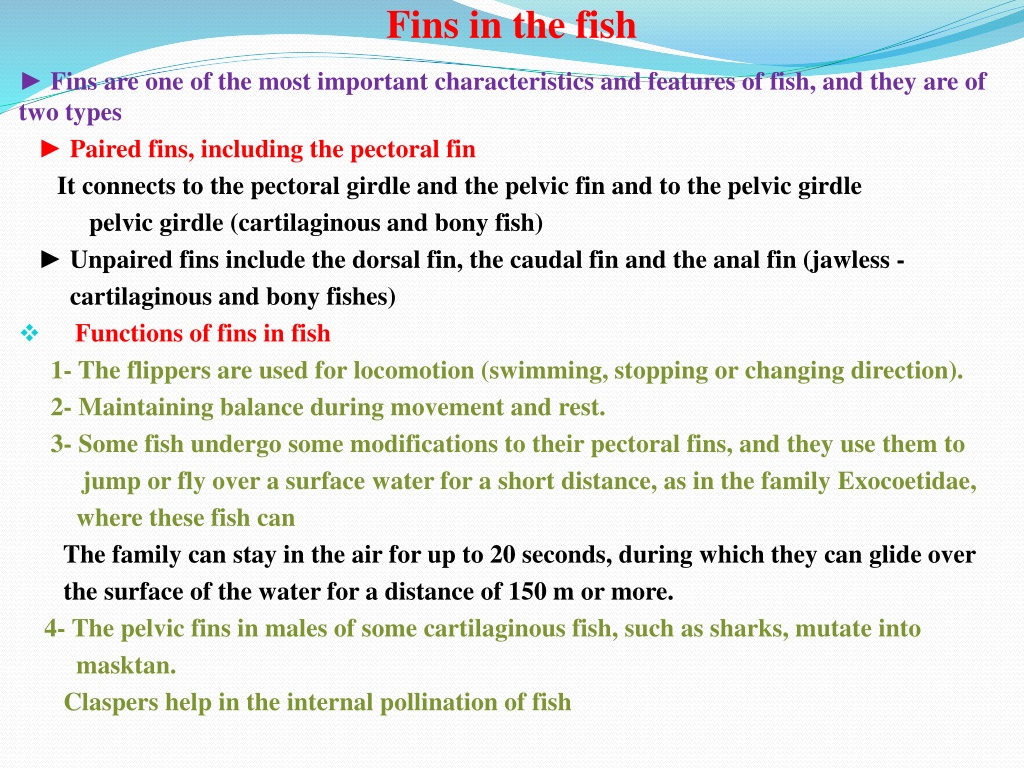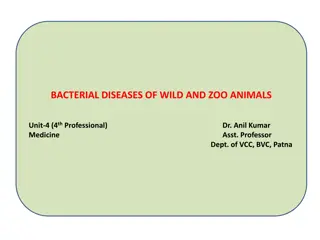
Insight into Fish Fins and Sensory Systems
Fish fins play crucial roles in locomotion, balance, and specialized behaviors like jumping. The sensory systems in fish, including sight, smell, and hearing, are adapted to their aquatic environment, aiding in survival, reproduction, and communication. Additionally, the gas bladder functions in buoyancy regulation and, in some species, respiration. Understanding these features enhances our appreciation of the diverse adaptations in fish species.
Uploaded on | 0 Views
Download Presentation

Please find below an Image/Link to download the presentation.
The content on the website is provided AS IS for your information and personal use only. It may not be sold, licensed, or shared on other websites without obtaining consent from the author. Download presentation by click this link. If you encounter any issues during the download, it is possible that the publisher has removed the file from their server.
E N D
Presentation Transcript
Fins in the fish Fins are one of the most important characteristics and features of fish, and they are of two types Paired fins, including the pectoral fin It connects to the pectoral girdle and the pelvic fin and to the pelvic girdle pelvic girdle (cartilaginous and bony fish) Unpaired fins include the dorsal fin, the caudal fin and the anal fin (jawless - cartilaginous and bony fishes) Functions of fins in fish 1- The flippers are used for locomotion (swimming, stopping or changing direction). 2- Maintaining balance during movement and rest. 3- Some fish undergo some modifications to their pectoral fins, and they use them to jump or fly over a surface water for a short distance, as in the family Exocoetidae, where these fish can The family can stay in the air for up to 20 seconds, during which they can glide over the surface of the water for a distance of 150 m or more. 4- The pelvic fins in males of some cartilaginous fish, such as sharks, mutate into masktan. Claspers help in the internal pollination of fish
Cont. Fins and eyes of fish 5 - The anterior ray props of the anal fin in males of the family Poeciliidae are modified into a gonopodium that helps in the internal fertilization of the female. The structure in fish may be: 1- cartilaginous skeleton with some calcareous deposits (cartilaginous fish) 2- Bony skeleton (most bony fish) 3- Bony & cartilaginous skeleton (bone cartilaginous fish) Where fish retain a lot of cartilage in their skulls, as in sturgeon fish And Bowfin Bowfin and salmon fish Salmons The sense of sight in most fish is characterized by sharpness, except for a few species (dark deep water fish from the seas and oceans), and these fish replace that by producing light in what is known as the bioluminescence process. The size, shape and locations of the eyes differ in different species The eyes of fish differ from the rest of the eyes of vertebrates because their anterior lens is spherical rather than They are flattened and it is believed that the fish are able to distinguish colors. The sense of smell in fish is accomplished through one middle nostril or two openings on both sides of the snout. These two openings lead to two closed sacs that are not connected to the mouth, representing the organ of smell.
Eyes Despite the presence of nasal openings, smell has nothing to do with breathing and is not linked to the respiratory system like other vertebrates. It may perform a respiratory function in a few fish, including lungfish (when the environment is dry). The importance of smell lies in locating food, especially for many species that feed in a dark environment or search for food at the bottom or through aquatic plants. Smell is also important in reproductive behavior, such as sex discrimination and returning to the egg-laying sites Smell also has a role in distinguishing enemies The auditory system is an inner ear where there is no external or middle ear. Fish normally breathe with gills, either the so-called air-bladder or gas bladder. gas-bladder or swim-bladder, often found in bony fish It does not perform a respiratory function except in some species, such as lungfish, where the bladder mutates into a A respiratory organ similar in function to the lungs of aquatic and terrestrial vertebrates, as well as fish that live in Shallow or stagnant waters with little oxygen use their bladders to breathe The primary function of the bladder is that it is a hydrostatic buoyancy organ whose function is to maintain the water balance in the body. Different depths, and other functions may be added to the bladder, such as helping to produce sound in some fish
Breathe of fish The sexes are mostly separate, and fertilization in most bony fishes is external, where the females lay eggs in the water, then the male sperm fertilizes them, and the eggs hatch from larvae that grow to reach the adult stage. Fertilization may be internal in cartilaginous fishes and some bony fishes. The fully formed digestive system is similar to what is found in the rest of the vertebrates in terms of the presence of the mouth, pharynx, stomach and intestines, in addition to the presence of glands such as the liver and pancreas The mouth in fish varies in size and shape, as it may be very small, as in fish Pipefish or large so that its opening reaches about one meter, as in sharks The location of the mouth differs from the head according to the type of feeding, so it is: 1- The inferior mouth (i.e., on the ventral side) of the head, as in the dog fish. and sturgeon 2- The subterminal (the upper jaw is slightly longer than the lower jaw) as in Dace fish 3- The two ends of the terminal (the jaws are equal) as in carp and trout Trout 4- superior, where the length of the lower jaw exceeds the upper jaw, as in some fish that feed near the surface, such as Gambusia affinis and Gar fish
General classification of fish Modern fish include between 20,000 and 25,000 species, and fish are classified in three main classes Jawless fish class (Jawless) Class: Agnatha It includes a few species up to 55 species that often live parasitic on other fish and are found in Lakes of North America and rivers of Europe, and in some temperate regions of the world - With serpentine bodies without scales - Its structure is composed of a group of cartilages, and it has individual fins, and it does not have fused fins The mouth is a jawless sucker, which is a round ventral opening located at the anterior end of the head It has a toothed tongue known as the tongue and horny teeth that arise from epidermal cells transformed into a horny substance on the surface, and it is worth noting that these teeth wear out and are replaced by others The more you erode
) ( Lampary Horny teeth Cartilaginous fish class: Chondrichthyes There are approximately 550 species of these fish that live mostly in the seas, and a few of them live in fresh water - The fish of this class is distinguished by the cartilaginous structure, where the backbone is fully formed, as well as the skull is cartilaginous Their skin is thick and often covered with placoid scales It has jaws with teeth, nostrils, single and paired fins
Class: Osteichthyes Class: Osteichthyes It represents the majority of live fish and the most diverse, with more than 20,000 species Widespread in the seas, rivers and oceans Its structure is mainly composed of bones, and some of them may retain many cartilages in the structure of the skull It has a special gill chamber on both sides of the head covered by a gill cover It has jaws with teeth, nostrils, single and paired fins The skin is often covered with scales, most of which are cycloid or ctenoid The class of bony fishes is divided into two subclasses. 1- Sarcopterygii phylum Sarcopterygii 2 -Actinopterygii (which includes the majority of bony fish) and is divided into three subclasses. A- It is under the class Chondrostei b - The Holostei primitive complete ossification C - and modern Teleostei (most bony ray-finned fish)






















